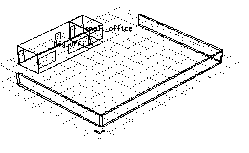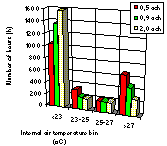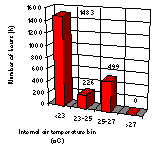
Figure 1. Computer model of the offices
Scotland normally experiences relatively mild summer temperatures, but the combination of high levels of solar irradiance with higher ambient temperatures could in some cases cause severe summer overheating. The classical engineering tools are not able to predict the thermal performance of proposed building configurations and thus designers are missing supporting information when selecting auxiliary systems for environmental control. In this circumstance, building energy and environmental simulation can be used to provide a solution.
The Miller Partnership, a construction group in Glasgow, solicited the Energy Design and Advice Scheme (EDAS) to assess the need for a mechanical cooling system as part of the proposed refurbishment programme to the GTW offices located at 34 Brown Street, Glasgow. EDAS then commissioned a comprehensive simulation study be conducted by the Energy Systems Research Unit (ESRU) at the University of Strathclyde to address this particular issue. Prior to the proposed alterations, these offices suffered from overheating in summer. The main alterations in terms of the simulation study are, the replacement of the south facing external wall with a new facade incorporating a low solar transmittance glazing, and insulation of the roof.
Since the main office plus the adjoining smaller office are representative for the other offices as well, the study concentrates on the named two offices only. A computer model of these two offices was generated based on geometric and constructional materials data provided by the client (see Figure 1). Of particular interest in this study, is the new glazing system, which is designed to cope with summer overheating. The glazing system consists of a sealed double glazing unit with a 6 mm inner pane of Pilkington K glass, 12 mm airspace, and a 6 mm outer pane of Pilkington SUNCOOL CLASSIC (20/34 Silver-coated). The main optical and thermal characteristics of this glazing unit are indicated in Table 1.

Figure 1. Computer model of the offices
| Light | Transmittance | 0.17 |
| Reflectance | 0.23 | |
| Solar Radiant Heat | Direct Transmittance | 0.11 |
| Reflectance | 0.19 | |
| Absorptance | 0.70 | |
| Total Transmittance | 0.22 | |
| Shading Coefficient | Short Wavelength | 0.13 |
| Long Wavelength | 0.12 | |
| Total | 0.25 | |
| U-value | W.m-2.K-1 | 1.9 |
Table 1. Main optical and thermal characteristics of the sealed double glazing
unit.
As the ventilation plays a very important role in the building's summer performance, the three cases considered were expressed in air change per hour (ach) as:
In order to predict summer indoor temperatures in the offices we have selected four different climate Test Reference Years (TRY) to assess the influence of a range of summertime temperatures. These are:
In terms of summer weather conditions in Glasgow, the climatic data for Kew will probably be on the warm side and the data for Eskdalemuir will be on the cool side.
The environmental conditions in the GTW offices after the proposed alternations were predicted by performing computer simulation using the building model and climate conditions as described above. A sample of the results which show outside and inside air temperatures during a typical summer week are illustrated in Figure2.

Figure 2. Predicted indoor air temperature from 10 July to 17 July for
clm67 climate data.
In order to assess thermal comfort conditions throughout the summer, internal air temperature frequency distributions were derived from the simulations. (see Figure 3).

Figure 3. Frequency distribution of the internal air temperature in
main office for try_kew climate.
The results for the office not equipped with mechanical ventilation nor with mechanical cooling, predict indoor air temperatures above 27 ° C occuring in the range of 170-730 hours per year depending on the type of summer. This equates to 15-50 working days.
The results for the office equipped with mechanical ventilation but no mechanical cooling system, predict indoor air temperatures above 27 ° C occuring in the range of 45-497 hours per year depending on the type of summer. This equates to 4-44 working days.
The results for the office equipped with a mechanical cooling system designed to limit the maximum indoor air temperatures to 27 ° C (i.e. top/uppermost storey office cooling only). Figure 4indicate the indoor temperature statistics for this case with try_kew climate data.

Figure 4. Frequency distribution of the internal air temperature in the
main office for try_kew climate.
A mechanical cooling system will result in the following energy requirements during the summer period:
| Zone | Energy Consumption | Max. Cooling Load |
|---|---|---|
| (kWh) | (W) | |
| Main Office | 188.6 | 2000 |
| Small Office | 35.5 | 500 |
| Total | 224.1 | 2500 |
The information provided from the simulation study is sufficient for the purpose of assisting the client's decision whether or not the offices should be equipped with the mechanical cooling system.
Based on these results, the recommendation to the client is to consider installation of the mechanical cooling system which limits the maximum indoor temperature to 27 °C during warm summer periods for the top/uppermost storey offices.
For more information: esru@strath.ac.uk